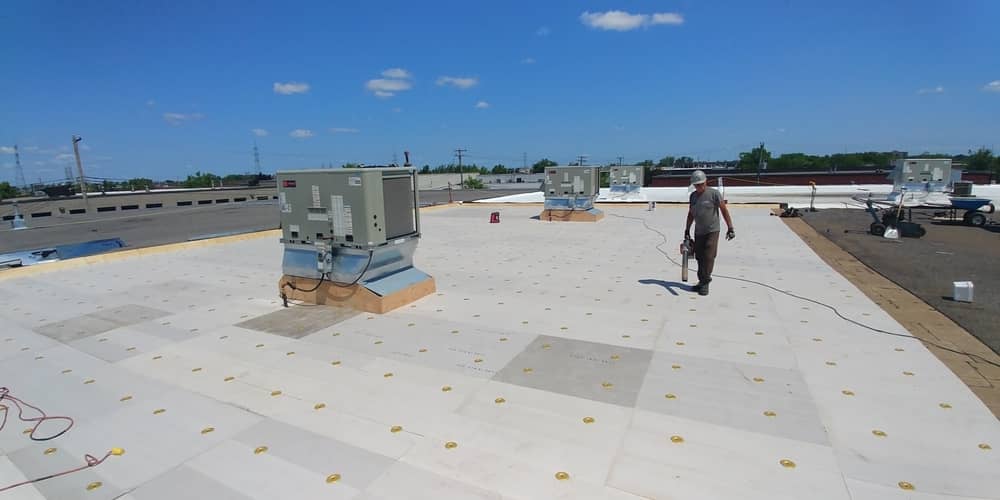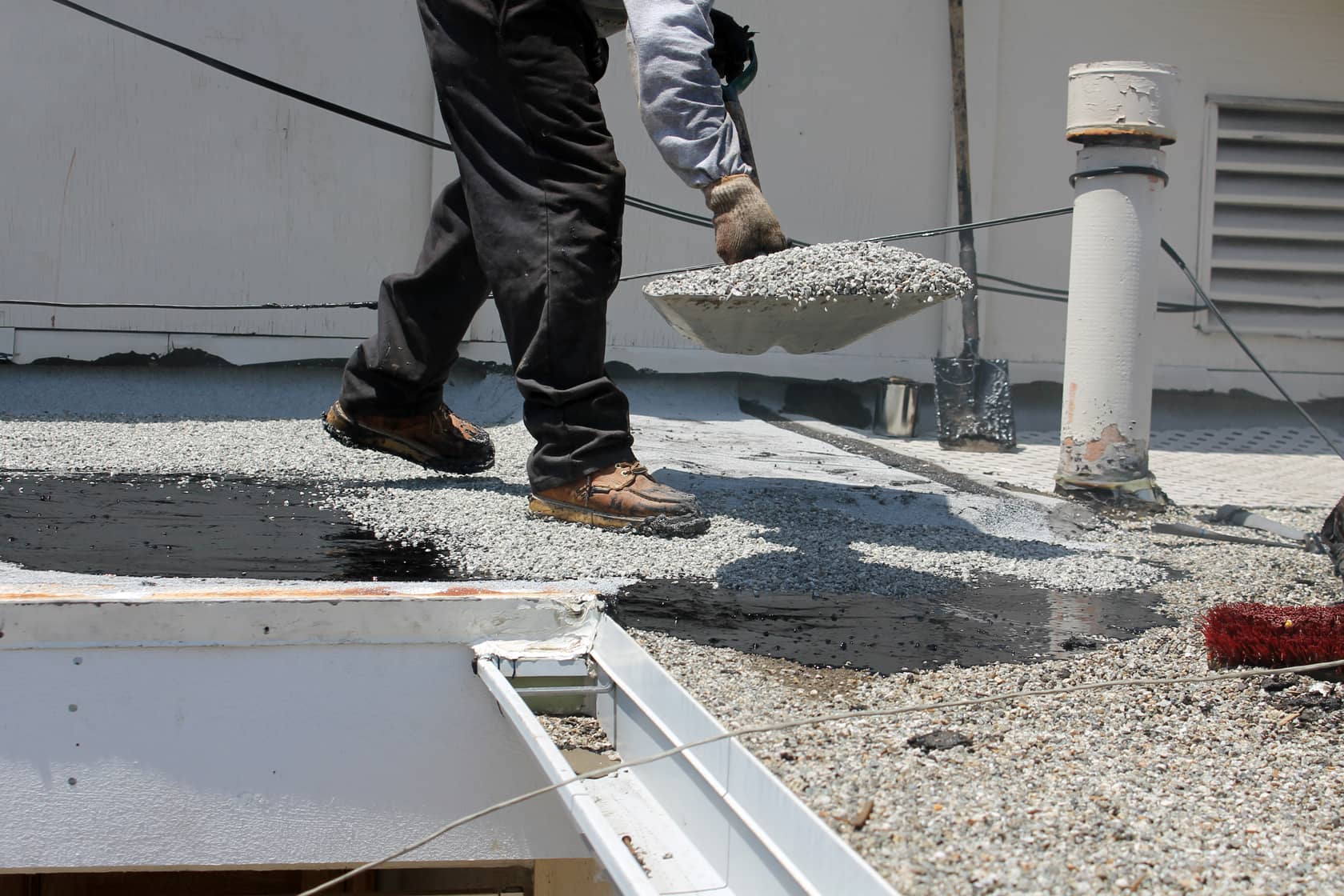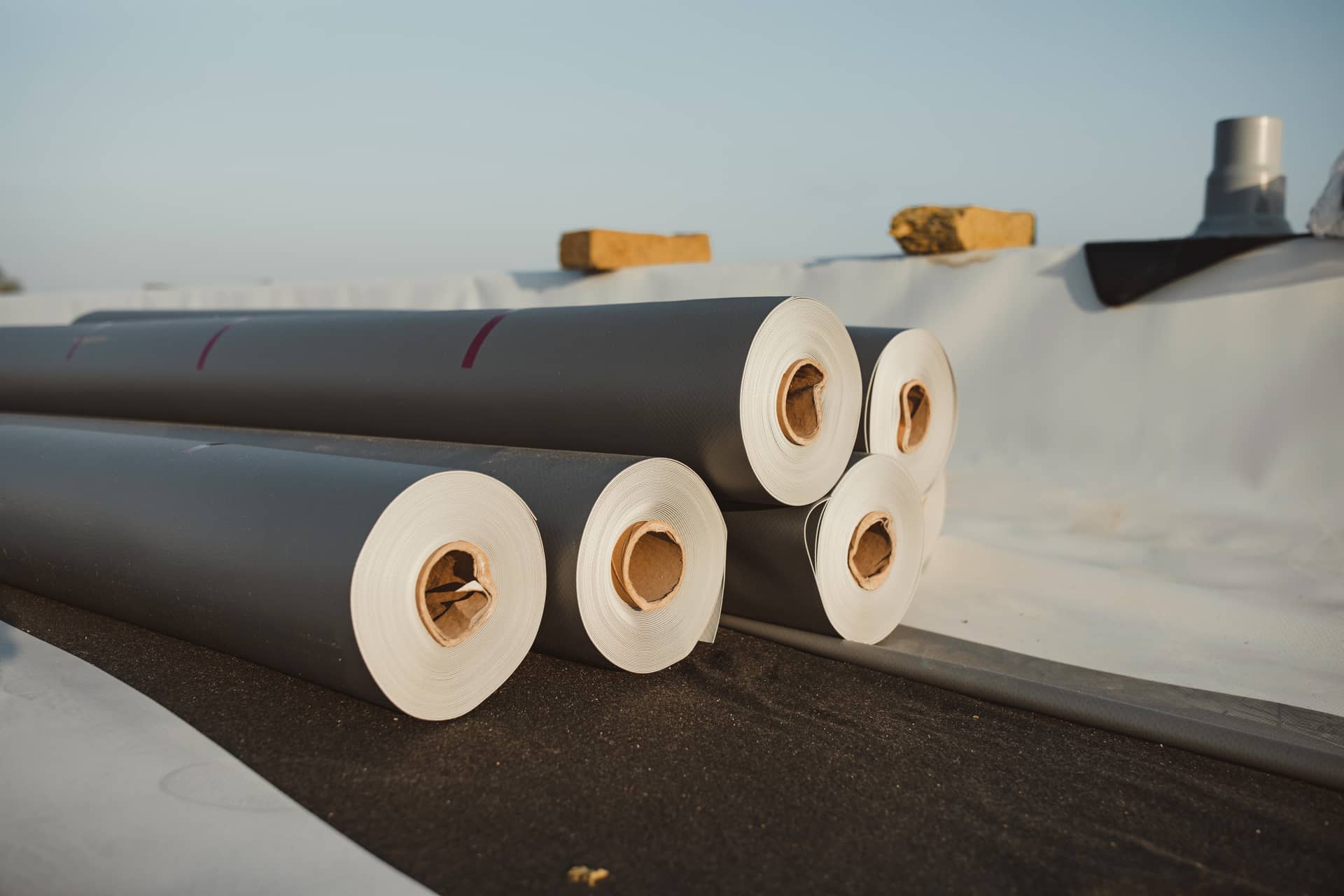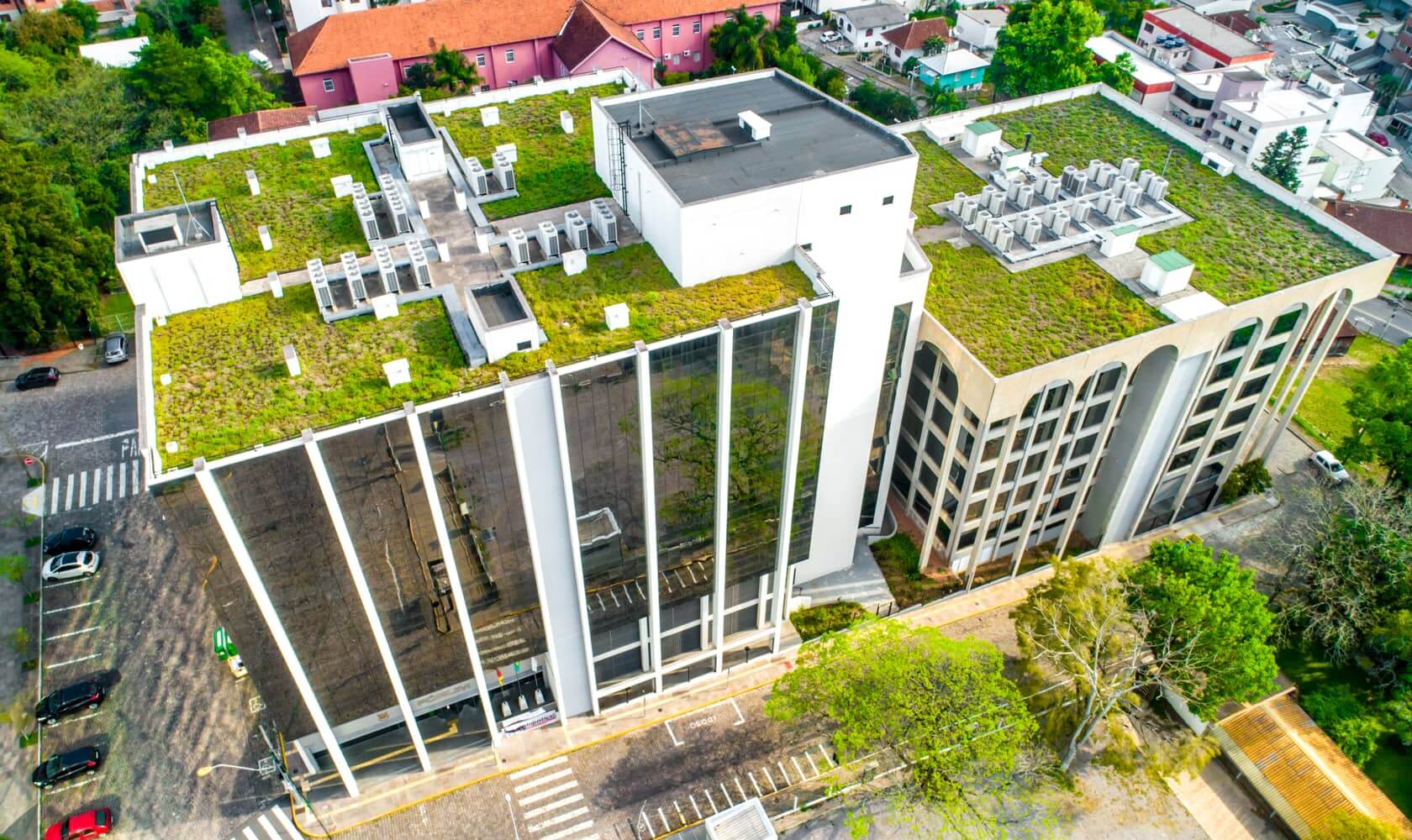
Home > Blog posts > The Different Types of Industrial Roofs
The Different Types of Industrial Roofs
Choosing the right type of industrial roof can seem like a significant challenge. With such a vast selection of available materials, it is important to know how to navigate the different features each one offers so that you can make an informed decision. Do you need to build or renovate your industrial roof?
Discover the different options you can choose from, their pros and cons, and the different standards with which you will need to comply.
Traditional Flat Roofs
Asphalt and gravel roofs have been the popular choice among the different types of industrial roofs for a long time. They are still popular today and are considered to be the traditional choice. This is a multilayer system that consists of several layers of roofing felt that are partially covered in liquid tar. Gravel is then added to the surface, protecting the membrane from UV rays.
Insulation is achieved with a hot tar kettle that not only produces strong odours, but also toxic vapours. This is why today, several other solutions are being considered, including waterproof membranes.

Flat Roofs with Waterproof Membranes
Although in traditional methods, gravel is used to protect the membrane from UV rays, more resistant membrane solutions have been developed since. Among these, there are flat roofs with waterproof membranes, which are made from different synthetic roofing materials.
These types of membranes stand out due to the installation process: they are laid out over the entire roof surface in a single layer. The fact that the installation process is quick is one of the reasons why they have become so popular! Their durability is another significant advantage. Properties obviously vary according to the material used.
EPDM Membranes (ethylene propylene diene terpolymer)
EPDM membranes are a one-ply (a single layer) roofing material composed of a combination of ethylene, propylene, diene and terpolymer. They stand out from other waterproof membranes due to the installation process. In fact, given that they are not a hot-melt material, joints are generally sealed with glue or special adhesive tape, without using any heat.
PVC Membranes (polyvinyl chloride-based membranes)
PVC roofing membrane is a synthetic membrane with a long lifespan, but which sells at a price that is sometimes higher than other similar solutions. The membrane is comprised of two plies of PVC that are glued together in a single layer on the roof.
Very efficient in terms of protection from insects and humidity, it is also more environmentally friendly. This membrane is generally mechanically installed and welded using hot air. When it comes to its properties, it is close to TPO, though often more expensive.
TPO Membranes (thermoplastic polyolefin)
This membrane comprised of thermoplastic is increasingly popular, and rightly so. It comes in different colours, though it is often chosen in white to reduce heat islands. It comes in rolls that are 10-, 12- or 20- inches wide.
TPO consists of a thin layer, and the different sections are fused together with a hot air welder. The installation is completed without flames or toxic emanations, and without using any glue. Just like PVC, this is one of the reasons why it is a healthier and safer option than others.
Among the other advantages it offers, it has a reflective surface that naturally repels UV rays, and it has a remarkably long lifespan.

Green Roofs
Green roofs have become an increasingly popular type of industrial roof. In fact, they not only offer an aesthetic advantage, but they are also great for the environment. Depending on your preferences and the time you want to dedicate to it, you can choose to create a simple green roof or a garden oasis, with plants, herbs, and flowers.
This type of roof is comprised of several layers, including a planting substrate, a draining layer and a root-proof barrier. These layers are placed on top of a waterproof membrane. You will, obviously, have to select the plants according to your local climate.

Modified Bitumen Roofing
Also known as “elastomer membrane”, modified bitumen roofing systems have been developed to replace the traditional asphalt and gravel roofing systems. The installation process is less damaging to the environment and is waterproof; it is, in fact, a better alternative.
Elastomer membranes are delivered in a roll, with a two-ply roofing installation, which consists of an underlayer and a finishing layer with a granulated surface. Seams are welded together using a torch, which means that the installation process is not as safe as for other types of membranes.

Pros and Cons for Each Type of Flat Roof
Every type of roof has its own set of pros and cons, although some offer many more advantages than others!
As a general rule, waterproof membranes like TPO, EPDM and PVC are greatly appreciated for their installation process. Perfectly adapted to large surfaces like industrial roofs, they can cover wide areas and are easy to cut, to adjust and position around the different roof accessories. Installation is quick, which means that they are also more affordable in terms of workmanship.
If you are looking for the most affordable choice among these different options, then you should turn to the TPO membrane. Just like for EPDM, this membrane stands out for its durability, resistance to moisture and mildew, and UV rays. This product is also very resistant to variations in temperature and fire.
EPDM might offer several of these advantages, although contrary to the TPO membrane, it will not reflect UV rays, which means that it absorbs heat. Moreover, the glue or adhesive tape used to bind it together can become weaker in colder temperatures and thus require more maintenance. PVC does offer properties that are similar to TPO.
Modified bitumen roofing systems (elastomer) come with several advantages. The main disadvantage, as mentioned above, is the installation process that can represent a fire hazard. Durability and flexibility are superior to those offered by asphalt and gravel roofs; though this last option is generally preferred given its more affordable price, it generally comes with several disadvantages, especially when it comes to the environment.
Finally, though more expensive and requiring more maintenance, a green roof offers several advantages. It retains rainwater, reduces heat islands, diminishes atmospheric pollution, and even contributes to your building’s thermal insulation and soundproofing. However, it is necessary to have a structure capable of supporting it.

Industrial Flat Roofs: Maintenance and Durability
No matter the type of industrial roof you have selected, regular maintenance is necessary to ensure maximum durability. Regular inspection will also help you avoid damages caused by a blocked drain, infiltrations, etc.
Although all membranes require maintenance, some are easier to maintain than others; we are referring to one-ply systems like TPO, EPDM and PVC membranes. Asphalt and gravel roofs require regular raking of the gravel to even it out, and it is sometimes necessary to add extra gravel to ensure that the first layer is not exposed to sunrays.
When it comes to a green roof, maintenance complexity will vary greatly according to the plants used. This is also a very durable option, especially because it contributes to protecting the membrane and thus helps maximize its lifespan.
When it comes to durability, TPO is often guaranteed 20 years, though it can be covered for up to 35 years! Lifespan is estimated to up to 40 years. As a comparison, EPDM generally comes with a 15-to-20-year warranty, while PVC can last up to 30 years.

Industrial Flat Roofs: Standards and Regulations
Industrial roofs are often subject to the same standards and regulations as any other type of flat roof. You will obviously have to comply with the National Building Code, but also with the different regulations imposed by your municipality.
In fact, in some districts of Montreal, roofs must be designed to reduce heat islands. In these instances, you will have to opt for a white or grey roof, or a green roof.
Other than these regulations, your roof will also have to comply with the different standards in relation to waterproofing, safety in the event of a fire, structural weight and resistance to wind uplift. Hydraulic calculations and safety will also have to be taken into account, among other things.
For an industrial roof installed professionally and in accordance with the different standards and regulations, we recommend that you trust in roofing experts: la Clinique de la toiture FCA.
Industrial Flat Roofs: Recent Innovations and Trends
Terrace roofs and green roofs are very popular. Depending on your business, these innovations could be the perfect option! Among other popular innovations, let’s also mention adding solar panels or skylights.
When it comes to the different materials, environmentally friendly products and white roofs are increasingly popular.
Are you hesitating as to what type of roof is best for your business? Contact us today!
Get an estimate in just 2 quick steps!
*Please allow a minimum of 24 hours for your request to be processed. Thank you for your understanding!
Do you know what type of industrial roof you have? No matter if you need help for maintenance, repairs or significant renovations, la Clinique de la toiture is here to help!
Need help?
Leave us your email address and we will contact you as soon as possible to assess your needs!
Put an end to your water infiltration your clogged drains your roof problems
Leave us your email address and we will contact you as soon as possible to assess your needs!
